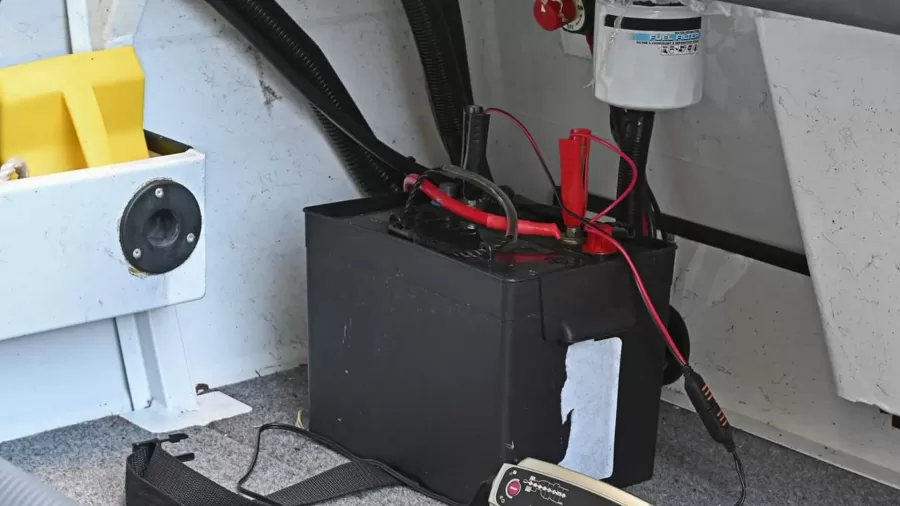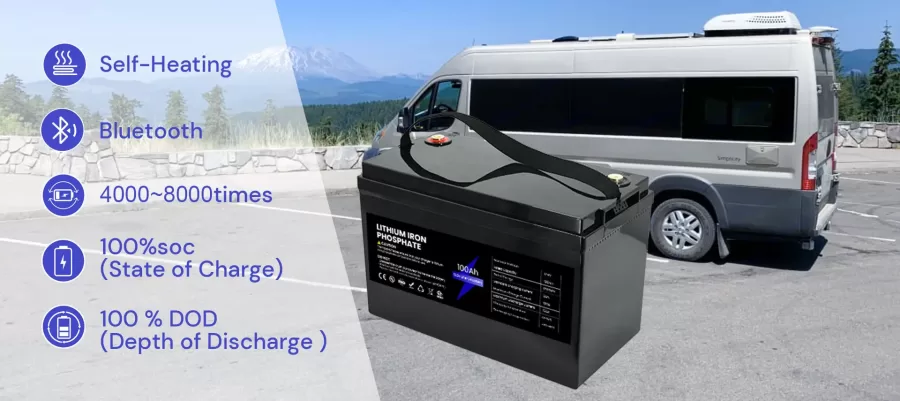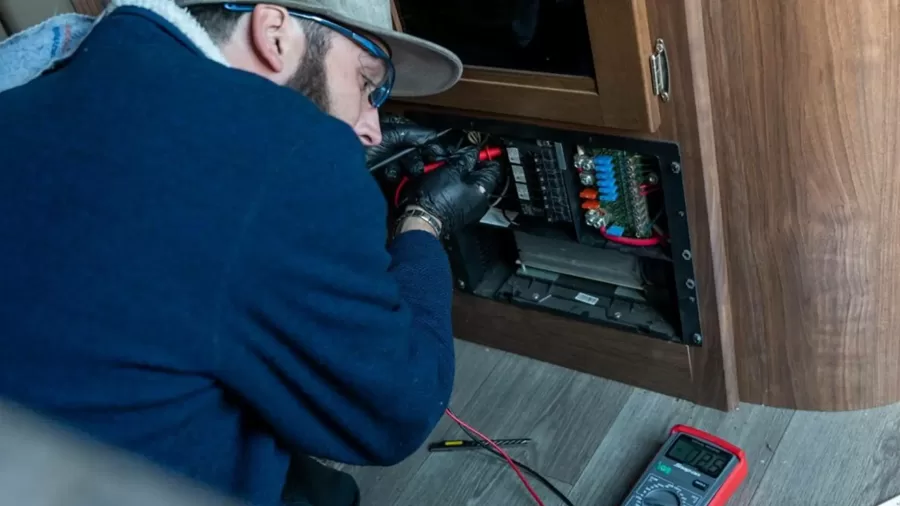Charging a deep-cycle RV battery properly maximizes its performance, longevity, and safety. In this comprehensive guide, we will delve into the features of deep cycle batteries, the significance of correct how to charge a deep cycle battery, how to select the right charger, and various charging methods available for RV deep cycle batteries.

What is an RV Deep Cycle LiFePO4 Battery, and Why Do You Need One?
An RV Deep Cycle LiFePO4 battery, also known as a Lithium Iron Phosphate battery, offers a compelling solution for RV owners seeking reliable power sources. Here are several reasons why you might consider this specific type of battery for your RV:
Deep Cycle Performance with Lithium-Ion Benefits:
Deep Discharge Capability: Compared to the regular deep cycle batteries, LiFePO4 batteries can be discharged up(often around 80%) without harm, This deep discharge capability makes them well-suited for powering RVs during extended periods of off-grid camping or boondocking when shore power is not available.
Lightweight Design: Compared to traditional lead-acid deep cycle batteries, LiFePO4 batteries are significantly lighter, reducing overall RV weight and potentially improving fuel efficiency.
Longer Lifespan: LiFePO4 batteries boast a much longer lifespan than lead-acid deep-cycle batteries, lasting for thousands of discharge and recharge cycles.
Faster Charging: These batteries can be recharged much faster than lead-acid deep cycle batteries, allowing you to take advantage of shorter charging opportunities.
Safer Chemistry: LiFePO4 is considered a very stable and safe Lithium-ion chemistry, offering better thermal stability and a lower risk of explosions compared to some other Lithium-ion types.
A deep-cycle LiFePO4 battery offers a stable and reliable power supply for various RV applications, including lights, water pumps, refrigerators, and entertainment systems.
In a word, investing in a deep cycle LiFePO4 battery for your RV is a smart choice for RV enthusiasts.

What Is The Significance Of Correct Charging Procedures For Deep-Cycle Batteries?
Maintaining the capacity, functionality, and lifespan of deep-cycle LiFePO4 batteries requires proper charging techniques. Reduced battery capacity, irreversible damage, and premature failure can occur due to overcharging or undercharging. Proper charging methods ensure that the battery reaches its full capacity during each charging cycle, maximizing its energy storage capabilities and extending its lifespan.
Four Charging Methods for Deep Cycle RV Batteries
We’ll guide you to know the advantages and operations of charging deep-cycle RV batteries.
Shore Power: It is a convenient and reliable option for charging RV batteries when parked at a campground for any suitable location with access to a 120V AC outlet. But you should have a converter or a dedicated LiFePO4 Battery charger in hand.
Generator: Charging your RV battery with a generator is a practical solution, especially when you’re camping off-grid or boondocking. Connect your RV’s power cable to the generator’s outlet (120V or 220V with a converter) following the safety guidelines provided in the generator’s manual.
Vehicle Alternator: While driving, your RV’s LiFePO4 batteries are replenished battery power from the vehicle’s alternator. This method provides a slow charge current and may require additional charging sources for faster replenishment.
Solar Power: Harnessing solar power to charge your LiFePO4 batteries is an excellent option for RVers looking to go off-grid and minimize reliance on traditional power sources.
You select one charging method or a combination of charging methods to charge your deep-cycle RV LiFePO4 batteries.
How to choose the right charger for your deep-cycle battery?
When selecting a charger, you should consider the various aspects including voltage, charging current, charging profile (continuous voltage or multi-stage charging), and safety features (temperature monitoring, overload prevention). Please contact the deep cycle battery manufacturer to get the charger solution.

Installing LiFePO4 Batteries in Your RV: A Step-by-Step Guide
This section provides a step-by-step guide for installation. It makes the installation process successful while prioritizing efficiency and safety with CM Batteries.
Selecting the Right Location:
Choose the location that meets safety standards and allows for easy maintenance and inspection of the battery. Once you’ve identified the ideal location, fasten the LiFePO4 battery using suitable brackets or mounts. This step minimizes vibrations and shocks during transit, promoting battery safety and longevity.
Connecting Terminals:
Follow CM Batteries’ guidelines and the manufacturer’s instructions to connect the LiFePO4 battery terminals to your RV’s electrical system accurately. Care about the overheating and electrical issues with a reliable power connection during this phase.
Testing the System:
Before hitting the road, do comprehensive tests to verify the LiFePO4 battery’s functionality, including voltage levels, charging, and discharging capabilities. Address any anomalies promptly to guarantee a trouble-free journey.
Commissioning and Calibration:
After installation, commission the LiFePO4 battery by charging it to full capacity using a compatible charger. Follow CM Batteries’ recommendations for initial charging procedures and ensure the battery reaches its maximum capacity before regular use. Additionally, calibrate the BMS settings to optimize performance and protect the battery from overcharging or over-discharging.
Installing LiFePO4 batteries transforms your RV into a reliable and efficient energy hub for your adventures. By following this step-by-step guide, you ensure seamless integration and dependable power solutions, reflecting CM Batteries’ commitment to quality and innovation for mobile applications.
What is the Fastest Way to Charge RV Batteries?
Lithium iron phosphate (LiFePO4) batteries offer remarkable advantages over traditional lead-acid batteries, especially when it comes to charging efficiency and performance. With their ability to accept higher charging currents and maintain stable voltage throughout the charging process, LiFePO4 batteries can indeed be charged at lightning speed when paired with a compatible smart charger. You’ll experience maximum efficiency with higher amperage charging, constant current, and constant voltage (CV) to prolong your battery’s lifespan. Our lithium batteries also feature automatic charging cutoff to prevent overcharging, ensuring your battery remains in top condition without worries and damage.
Regular FAQ about RV Batteries Charging
Q: How to charge a deep cycle battery in series?
A: Each battery should be charged individually, and a voltmeter to check the voltage of each battery to ensure it is within 0.05V or 50mV. Then, the batteries can be connected in series.
Remember never to mix batteries with different voltages. Using batteries with different voltages will cause uneven charging and discharging rates, resulting in stress and imbalance between the batteries. If the batteries become unbalanced, disconnect them, charge them individually, and then reconnect. You can refer to this specific charging guide for LiFePO4 batteries.
Q: How to charge a deep cycle battery with a charger?
A: Please charge your lifepo4 battery with a dedicated lithium iron phosphate battery charger and plug the charger directly into the battery. The charger will automatically complete the charging process.
Q: How to charge a deep cycle battery at home?
A: Charging your RV battery at home with a charger is a great way and make sure your battery is fully charged before your next trip. See this article for specific guidance: everything you need to know about lifepo4 battery charging.
RV batteries serve as the lifeblood of your recreational vehicle. Choosing the right RV battery is crucial for ensuring optimal performance, longevity, and safety of your recreational vehicle’s electrical system. Click to learn how to choose the right RV battery.


